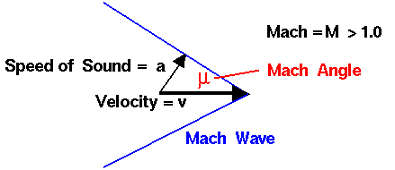Related Resources: calculators
Mach Wave Calculator
Fluids Flow Design and Engineering
Mach Wave Calculator and Equations
In fluid dynamics, a Mach wave is a pressure wave traveling with the speed of sound caused by a slight change of pressure added to a compressible flow. These weak waves can combine in supersonic flow to become a shock wave if sufficient Mach waves are present at any location. Such a shock wave is called a Mach stem or Mach front. Thus, it is possible to have shock less compression or expansion in a supersonic flow by having the production of Mach waves sufficiently spaced (cf. isentropic compression in supersonic flows). A Mach wave is the weak limit of an oblique shock wave where time averages of flow quantities don't change (a normal shock is the other limit). If the size of the object moving at the speed of sound is near 0, then this domain of influence of the wave is called a Mach cone.
A Mach wave propagates across the flow at the Mach angle μ, which is the angle formed between the Mach wave wave front and a vector that points opposite to the vector of motion. It is given by
Where
M = Mach number
µ = Mach wave angle

Mach wave
Mach waves can be used in schlieren or shadowgraph observations to determine the local Mach number of the flow. Early observations by Ernst Mach used grooves in the wall of a duct to produce Mach waves in a duct, which were then photographed by the schlieren method, to obtain data about the flow in nozzles and ducts. Mach angles may also occasionally be visualized out of their condensation in air, for example vapor cones around aircraft during transonic flight.
Reference:
- Sasoh, Akihiro (2020-01-02). "4.3 Oblique Shock Wave". Compressible Fluid Dynamics and Shock Waves. Nagoya, Japan: Springer Nature Singapore.
- E. Carscallen, William; Patrick, H. Oosthuizen (2013-07-12). Introduction to Compressible Fluid Flow (2 ed.). CRC Press.
- Mach angle at NASA.
Related:
- Shock Mach Diamond Formulas and Calculator
- NACA Airfoil Plotter and Equations
- de Laval Nozzle Exhaust Gas Velocity Equations and Calculator
- Pitot-Static Tube Velocity of Fluid Flow Measurement Calculator and Equation
- Estimating UAV Drone Propeller Thrust Equations and Calculator
- Aerospace, Aviation Metals Review
- Aviation Maintenance (FAA-H-8083-30A) Technician Handbook General
- Aviation Maintenance Technician Handbook Airframe (FAA-H-8083-31A) Volume 1
- Aviation Maintenance Technician Handbook Powerplant Volume 1
- Aviation Maintenance Technician Handbook Powerplant (FAA-H-8083-32A) Volume 2
- Aviation Maintenance Technician Handbook Airframe (FAA-H-8083-31A) Volume 2